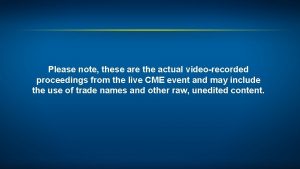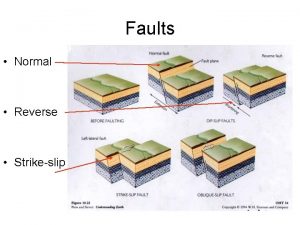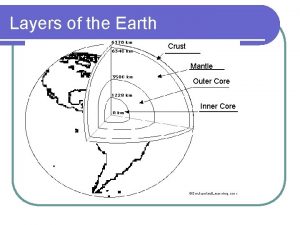Adaptive value of torsion Torsion moves the mantle


















































- Slides: 50

Adaptive value of torsion? • • Torsion moves the mantle cavity and associated organs such as anus, nephridiopores and gonopores to a more anterior position – Easy to retract – Undisturbed water to mantle cavity … Many of the evolutionary pathways in posttrosional gastropods seem to involve modification to prevent fouling of the anterior region of the mantle cavity (which includes the ctenidia) and head


Classes of Molluscs Class Cephalopoda Squids, octopuses, nautiluses, and cuttlefish All marine predators Foot is in the head region – Modified for expelling water from mantle cavity Range from 2 cm to the giant squid – Largest invertebrate Cephalopod fossil record goes back to the Cambrian – Earliest shells were straight

These exclusively marine animals are characterized by: bilateral body symmetry a prominent head a set of arms or tentacles modified from the primitive molluscan foot. inkfish, referring to their common ability to squirt ink.

Classes of Molluscs Cephalopods – Mostly marine – Octopuses mostly intertidal – Squids are deep-sea animals Nautilus – Remaining survivor of nautiloids – Series of gas chambers in shell helps maintain neutral buoyancy Octopi and squids apparently evolved from early straight-shelled ancestors Ammonoids – Extinct but had elaborate shells

Cephalopoda www. practicalfishkeeping. co. uk Tnaqua. org With a reduced shell, you need other defenses. Howto. gd 6

7

A nautilus is the only shelled cephalopod. Does it produce ink? siphuncle 8


extant subclasses: Coleoidea, which includes octopuses, squid, and cuttlefish; and Nautiloidea, represented by Nautilus and Allonautilus. In the Coleoidea, the molluscan shell has been internalized or is absent, whereas in the Nautiloidea, the external shell remains. There are over 800 extant species of cephalopod Cephalopods are found in all the oceans of Earth. None of them can tolerate freshwater

Classes of Mollusks Class Cephalopoda -Active marine predators -Foot has evolved into a series of arms equipped with suction cups -Squids have 10; octopuses, 8; and nautiluses, 80 to 90 -Have highly developed nervous systems -Exhibit complex patterns of behavior and a high level of intelligence

Classes of Mollusks Class Cephalopoda -Many have an ink sac and are capable of expelling ink to confuse predators -Octopuses and squids can change color using pouches of pigment called chromatophores

Ink confuse predators a muscular bag which originated as an extension of the hind gut its contents – almost pure melanin upon expulsion, with mucus Pseudomorph

Classes of Molluscs Form and Function – Shell • Nautiloid and ammonoid shells had gas chambers allowing them to swim • Cuttlefish shell is enclosed in mantle • Squid shell is a thin strip called the pen, enclosed in mantle • Octopus has completely lost the shell

Cuttlebone The gladius, pen (chitinous)

Classes of Molluscs Locomotion – Cephalopods swim by forcefully expelling water through a ventral funnel or siphon – Control direction and force of the water, thus determining its speed – Lateral fins of squids and cuttlefishes are stabilizers – Nautilus swims mainly at night – Octopuses mainly crawl on the bottom but can swim backward by spurting jets of water • Some with webbing between their arms swim with a medusa-like action – Active life of cephalopods is reflected in their respiratory, circulatory and nervous systems.


Circulatory system Cephalopods are the only mollusks with a closed circulatory system. Coleoids have two gill hearts (also known as branchial hearts) that move blood through the capillaries of the gills. A single systemic heart then pumps the oxygenated blood through the rest of the body.


Classes of Molluscs Nervous and Sensory Systems – Cephalopod brain is the largest of any invertebrate – Squids have giant nerve fibers – Sense organs are well-developed • Eyes are complex, complete with cornea, lens, and retina – Can learn by reward and punishment, and by observation of others – Cephalopods lack a sense of hearing but have tactile and chemoreceptor cells in their arms


Classes of Molluscs Communication – Use chemical and visual signals to communicate – Chromatophores are cells in the skin that contain pigment granules – Contractions of the muscle fibers attached to the cell boundary causes the cell to expand change the color pattern – Color patterns can be changed rapidly – Deep-water cephalopods have elaborate luminescent organs – Ink sac empties into rectum; • Contains ink gland that secretes sepia when animal alarmed

As well as providing camouflage with their background some cephalopods bioluminesce, shining light downwards to disguise their shadows from any predators that may lurk below Cephalopods can change their colors and patterns in milliseconds, whether for signalling (both within the species and for warning) or active camouflage, as their chromatophores are expanded or contracted

Chromatophore


Cephalopods are widely regarded as the most intelligent of the invertebrates, and have well developed senses and large brains. The nervous system of cephalopods is the most complex of the invertebrates Cephalopods have also been known to climb out of their aquaria, maneuver a distance of the lab floor, enter another aquarium to feed on the crabs, and return to their own aquarium

Paul the Octopus


Classes of Molluscs Reproduction – Sexes are separate – Fertilized eggs leave oviduct and are attached to stones, etc. • Hatch into juveniles with no free-swimming larval stage



Classes of Molluscs Class Bivalvia Mussels, clams, scallops, oysters, and shipworms Range in size from 1– 2 mm in length to the giant South Pacific clams Most are sedentary filter feeders Bivalves lack a head, radula, or other aspects of cephalization Most are marine

Bivalves include scallops, mussels, clams, oysters, and are aptly named for having 2 valves. Orientation is a Left and Right valve. Great filter feeders www. ct. gov www. molluscs. at They are a girl’s best friend. www. snipview. com

Freshwater bivalves are at high risk of extinction due to habitat loss/degradation, invasive species, pollutants. * www. carnegiemnh. org www. research. amnh. org www. ec. gc. ca www. blackwarrior. org

Classes of Molluscs Native freshwater clams in the U. S. are the most jeopardized animal group – Of more than 300 species once present, 12 are extinct, 42 are threatened or endangered and 88 more are of concern – Sensitive to water quality changes, including pollution and sedimentation

Classes of Molluscs Form and Function – 2 shells or valves are held together by a hinge ligament – Valves are drawn together by strong adductor muscles – Umbo is the oldest part of the shell with growth occurring outward in rings – Pearls are produced when an irritant is lodged between the shell and mantle • Layers of nacre are secreted around the foreign material


Classes of Molluscs Body and Mantle – Visceral mass is suspended from the dorsal midline – Foot is attached anteroventrally – Ctenidia hang down on each side, each covered by a fold of the mantle – Posterior edges of the mantle folds form excurrent and incurrent openings – In burrowing clams, mantle forms long siphons to reach the water above

Classes of Molluscs Locomotion – – – Foot is extended out from between the valves Blood is pumped into the foot Foot swells and anchors the bivalve in the mud Shortening of the foot pulls the clam forward Scallops clap valves to create a jet propulsion


Classes of Molluscs Gills – Both mantle and gills perform gaseous exchange • Water enters incurrent siphon • Passes into water tubes through pores • Exits through the excurrent siphon

Classes of Molluscs Feeding – Suspended organic matter enters incurrent siphon – Gland cells on gills and labial palps secrete mucus to entangle particles – Food in mucous masses slides to food grooves at lower edge of gills – Cilia and grooves on the labial palps direct the mucous mass into mouth – Some bivalves feed on deposits in sand – Shipworms excavate particles of wood – Septibranchs draw in crustaceans by creating a sudden inflow of water



Classes of Molluscs Reproduction and Development – Sexes usually separate – Gametes discharged in suprabranchial chamber are carried out in excurrent flow – Fertilization usually external – Freshwater clams have internal fertilization • Sperm enter the incurrent siphon to fertilize eggs in water tubes of the gills – Larvae develop into a bivalved glochidia stage • Attaches to gills of passing fish where they live briefly as parasites • Eventually sink to begin independent life on the streambed • “Hitchhiking” having helped distribute the species

The glochidium is a specialized parasitic veliger larva found in freshwater bivalves. www. research. amnh. org That fish lure is part of the mantle! movie of lure in action: http: //www. youtube. com/watch? v=UQLWu. Tg 9 Fc. Y


Nervous system The sedentary habits of the bivalves have meant that in general the nervous system is less complex than in most other molluscs The animals have no brain the nervous system consists of a nerve network and a series of paired ganglia.

Learning Objectives 1. Describe common features shared by all molluscs. 2. Characterize each of these four classes of molluscs (describe distinguishing features) A. Polyplacophora B. Gastropoda C. Bivalvia D. Cephalopoda

http: //www. justjulieb. com/the-notable-nudibranch/ www. biobull. org www. mesa. edu. au www. asnailsodyssey. com
 Apa itu value creation
Apa itu value creation Adaptive value of behavior
Adaptive value of behavior Adaptive value of behavior
Adaptive value of behavior Adaptive value of behavior
Adaptive value of behavior Mantle magma
Mantle magma Heating mantle risk assessment
Heating mantle risk assessment Rocks are classified according to
Rocks are classified according to Earth mantle
Earth mantle Taking up the mantle
Taking up the mantle Mantle wedge
Mantle wedge Whats the composition of the mantle
Whats the composition of the mantle Maintenance rituximab mantle cell lymphoma
Maintenance rituximab mantle cell lymphoma Earth's mantle
Earth's mantle Mantle biblical definition
Mantle biblical definition Why is mantle material compared to the consistency of fudge
Why is mantle material compared to the consistency of fudge Mechanical layers of the earth
Mechanical layers of the earth Pass the mantle
Pass the mantle Core mantle crust
Core mantle crust What best describes the mantle of earth
What best describes the mantle of earth The 2 types of crust
The 2 types of crust Extreme earth
Extreme earth Mantle convection diagram
Mantle convection diagram Mantle made of
Mantle made of The layers of an egg
The layers of an egg Copanlisib package insert
Copanlisib package insert Layers of the earth rap
Layers of the earth rap Mantle layer
Mantle layer Mantle convection and plate tectonics
Mantle convection and plate tectonics Normal fault
Normal fault What causes convection currents in earth's mantle
What causes convection currents in earth's mantle Which layer is the least dense
Which layer is the least dense Core mantle crust
Core mantle crust Mantle magma
Mantle magma Crust mantle core
Crust mantle core Plate boundaries song
Plate boundaries song How is heat transferred in the mantle
How is heat transferred in the mantle Pangea explanation
Pangea explanation Core crust mantle
Core crust mantle Crust mantle core
Crust mantle core Thứ tự các dấu thăng giáng ở hóa biểu
Thứ tự các dấu thăng giáng ở hóa biểu Vẽ hình chiếu vuông góc của vật thể sau
Vẽ hình chiếu vuông góc của vật thể sau Làm thế nào để 102-1=99
Làm thế nào để 102-1=99 Hát lên người ơi
Hát lên người ơi Tỉ lệ cơ thể trẻ em
Tỉ lệ cơ thể trẻ em Sự nuôi và dạy con của hổ
Sự nuôi và dạy con của hổ Lời thề hippocrates
Lời thề hippocrates đại từ thay thế
đại từ thay thế Quá trình desamine hóa có thể tạo ra
Quá trình desamine hóa có thể tạo ra Công thức tính thế năng
Công thức tính thế năng Hát kết hợp bộ gõ cơ thể
Hát kết hợp bộ gõ cơ thể Thế nào là mạng điện lắp đặt kiểu nổi
Thế nào là mạng điện lắp đặt kiểu nổi










































































